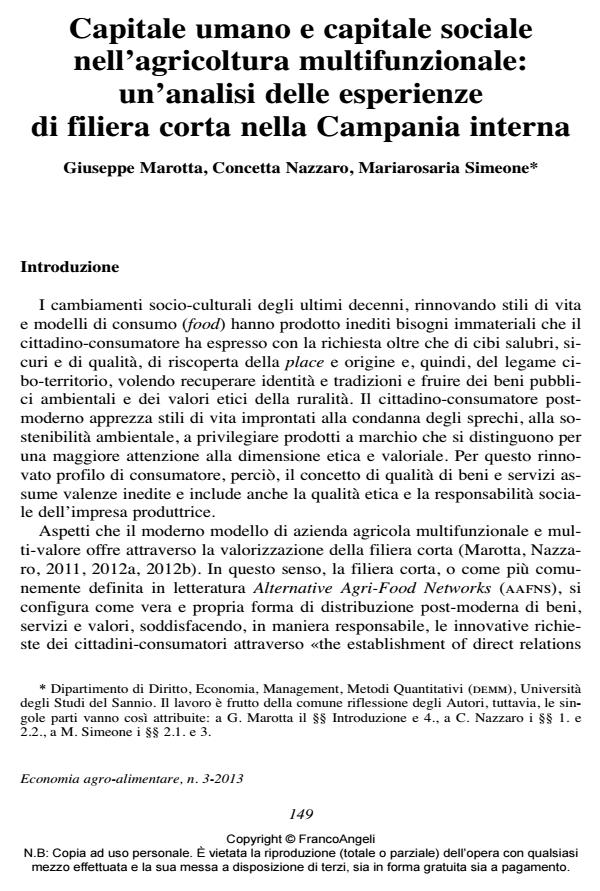Capitale umano e capitale sociale nell’agricoltura multifunzionale: un’analisi delle esperienze di filiera corta nella Campania interna
Titolo Rivista ECONOMIA AGRO-ALIMENTARE
Autori/Curatori Giuseppe Marotta, Concetta Nazzaro, Mariarosaria Simeone
Anno di pubblicazione 2014 Fascicolo 2013/3
Lingua Italiano Numero pagine 25 P. 149-173 Dimensione file 470 KB
DOI 10.3280/ECAG2013-003009
Il DOI è il codice a barre della proprietà intellettuale: per saperne di più
clicca qui
Qui sotto puoi vedere in anteprima la prima pagina di questo articolo.
Se questo articolo ti interessa, lo puoi acquistare (e scaricare in formato pdf) seguendo le facili indicazioni per acquistare il download credit. Acquista Download Credits per scaricare questo Articolo in formato PDF

FrancoAngeli è membro della Publishers International Linking Association, Inc (PILA)associazione indipendente e non profit per facilitare (attraverso i servizi tecnologici implementati da CrossRef.org) l’accesso degli studiosi ai contenuti digitali nelle pubblicazioni professionali e scientifiche
The attention to business networks, therefore to the business relationships among companies, supply chain operators, manufacturers and consumers, aimed at commercial transactions, exchange of information, sharing of norms and associations of resources become an asset in the definition of modern strategies of competitive advantage for agribusiness companies. In this perspective, the short chain represents an interesting business model network, rooted in the specific territorial context, which, through specific organizational characteristics and diversified multi-functional activities, is enhanced by human and social resources, internal and external (at the company), and able to act on the local aggregation process and territorial value creation. Share capital and human capital become, therefore, the determining factors for the effectiveness of the short food supply chain experiences, especially in the inland areas, and for wider dissemination and sharing of the value created. Aim of this work is an analysis of the functional relationships between social capital and human capital in farms, diversified and multifunctional, which have taken paths of short chain. For this purpose, the empirical verification aimed to investigate how the quality of human capital affects the effectiveness of relational networks and how it could lead to have impacts on the performance of short chain, improving its ability to create value for the enterprise and for the territory. The results of the study made possible to understand the mechanisms and the strategic variables of this innovative mode of direct governance of transactions between producer and consumer-citizen, in specific territorial rural systems, and to indicate useful policy implications.
Parole chiave:Multifunctionality, short-wine supply chain, human capital, social capital, value creation
Jel codes:Q12, Q13, Q18, Q19, Q56
- It's a jungle out there - the strange animals of economic organization in agri-food value chains C. Nazzaro, G. Marotta, M. Stanco, pp.337 (ISBN:9789086868445)
- Short Food Supply Chain and Resilience: An Analysis during COVID-19 Pandemic in Inner Areas of Campania Region Anna Uliano, Marcello Stanco, Concetta Nazzaro, in Sustainability /2023 pp.12721
DOI: 10.3390/su151712721 - Which Stakeholders’ Sector Matters in Rural Development? That Is the Problem Tomasz Kusio, Mariantonietta Fiore, in Energies /2022 pp.454
DOI: 10.3390/en15020454 - Agrarian landscapes: from marginal areas to cultural landscapes—paths to sustainable tourism in small villages—the case of Vico Del Gargano in the club of the Borghi più belli d’Italia Simona Giordano, in Quality & Quantity /2020 pp.1725
DOI: 10.1007/s11135-019-00939-w
Giuseppe Marotta, Concetta Nazzaro, Mariarosaria Simeone, Capitale umano e capitale sociale nell’agricoltura multifunzionale: un’analisi delle esperienze di filiera corta nella Campania interna in "ECONOMIA AGRO-ALIMENTARE" 3/2013, pp 149-173, DOI: 10.3280/ECAG2013-003009